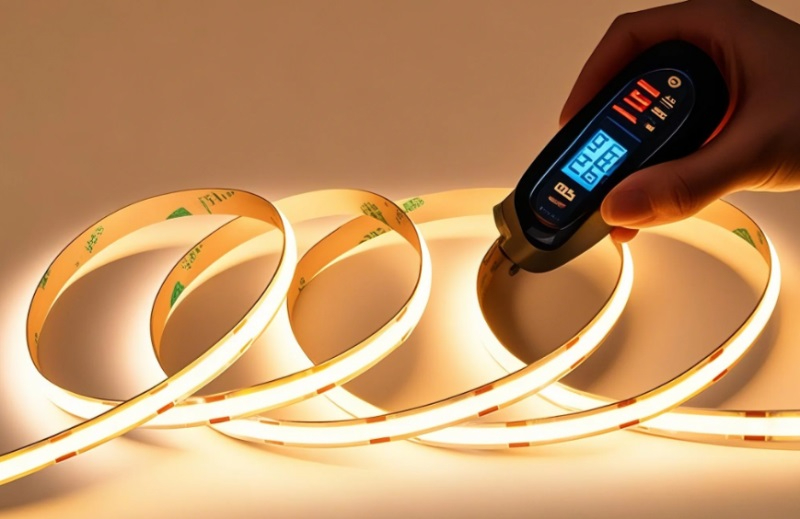As high-density COB (Chip-on-Board) LED strips become the gold standard for seamless, ultra-bright lighting, their thermal management challenges grow exponentially. With hundreds of tightly packed chips generating concentrated heat, improper dissipation can lead to rapid lumen degradation, color shifts, and even premature failure. This article explores cutting-edge solutions to keep high-density COB strips cool, efficient, and durable for demanding residential, commercial, and architectural applications.

Why Thermal Management is Critical for High-Density COB Strips
COB technology’s dense chip arrangement (up to 500 LEDs/m) creates unparalleled uniformity but also concentrates heat in small areas. Without effective cooling:
- Lifespan Drops by 50%: Temperatures above 85°C accelerate phosphor decay, reducing lifespan from 50,000 hours to 25,000.
- Efficiency Plummets: Every 10°C rise cuts light output by 5–7% due to increased forward voltage.
- Safety Risks Emerge: Overheating can delaminate solder joints or damage drivers.
6 Innovative Thermal Solutions for High-Density COB Strips
1. Advanced Substrate Materials: Beyond Traditional Aluminum PCBs
- Ceramic-Based Boards: Aluminum nitride (AlN) or silicon carbide (SiC) substrates offer 3–5× better thermal conductivity (180–220 W/mK vs. 1–3 W/mK for standard FR4).
- Hybrid Metal-Core PCBs: Layered designs with copper-clad aluminum (CCA) or graphene-enhanced cores disperse heat laterally, reducing hot spots.
- Application Tip: Use ceramic substrates in enclosed fixtures (e.g., recessed ceiling coves) where airflow is limited.
2. Active Cooling Systems: Integrating Fans & Liquid Channels
- Micro-Fan Arrays: Ultra-thin (3–5mm) brushless DC fans embedded in aluminum channels reduce COB strip temperatures by 15–20°C.
- Liquid-Cooled Tracks: Closed-loop systems circulate coolant through hollow extrusions, ideal for high-power (>30W/m) installations like museum lighting.
- Case Study: A luxury retail store achieved 40% brightness stability improvement using liquid-cooled COB strips in 24/7 display cases.
3. Phase-Change Thermal Interface Materials (TIMs)
Replace traditional thermal adhesives with:
- Paraffin-Based TIMs: Absorb heat during phase transitions (solid↔liquid) at 45–60°C, ideal for fluctuating loads.
- Metal-Alloy Pads: Gallium-based alloys provide 25–35 W/mK conductivity and self-healing properties.
4. Smart Thermal Management with IoT Sensors
- Real-Time Monitoring: Bluetooth/Wi-Fi-enabled temperature sensors (e.g., Sensirion STS3x) trigger automatic dimming or cooling activation.
- Predictive Analytics: Machine learning algorithms analyze historical data to preemptively adjust power output before overheating occurs.
5. Structural Design Innovations
- Asymmetric Fin Extrusions: Angled fins increase surface area by 200% without widening the profile, maintaining sleek aesthetics.
- Segmented Heat Zones: Divide strips into 10–20cm independently cooled sections to isolate thermal stress.
6. Passive Cooling Enhancements
- Graphene Coatings: Apply 10–20μm graphene layers to PCB surfaces for anisotropic heat spreading (1,500–5,000 W/mK in-plane).
- Vapor Chamber Integration: Flat heat pipes (0.8–1.2mm thick) transfer heat from COB clusters to remote heatsinks.
Installation Best Practices for Optimal Heat Dissipation
- Avoid Direct Contact with Insulation: Maintain a 25mm air gap between COB strips and thermal barriers.
- Use Thermally Conductive Mounting Tape: 3M 8810 series (5.5 W/mK) outperforms standard acrylic adhesives.
- Limit Continuous Runs: For >5m installations, split into segments with separate drivers to distribute thermal load.
Future Trends: Self-Cooling COB Technologies
- Electrocaloric Polymers: Experimental materials that absorb heat when exposed to electric fields (University of Science and Technology of China, 2024).
- Micro-Peltier Modules: Thermoelectric coolers integrated into COB packages for spot cooling of high-current chips.
Conclusion
Modern high-density COB LED strips demand equally advanced thermal strategies. By combining ceramic substrates, active cooling, IoT-enabled controls, and novel materials like graphene, installers can unlock 100% performance potential while ensuring decade-long reliability. As COB power densities continue rising (projected 200W/m² by 2026), proactive thermal design will separate premium lighting projects from costly failures.
If you need assistance from professionals, feel free to contact us. We are here to provide you with expert help and support for all your needs. Don't hesitate to reach out to our team for personalized assistance and solutions. We look forward to serving you.

